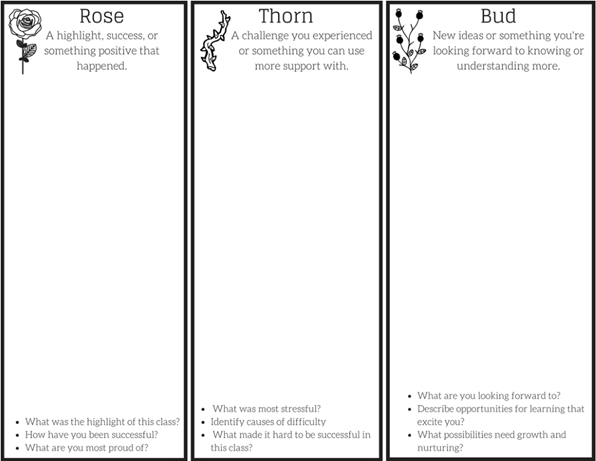Keeping students engaged in course content is a challenge for all faculty, whether a legacy online teaching pro or a newbie to this space. Perhaps you’re a faculty member who already teaches online and caught a spark of inspiration by the recent redux shift to online learning due to the pandemic. You’d like to re-create your assessments to leverage newer instructional technologies or provide a more engaging method for assessing learning outcomes. Perhaps a rapid shift to various forms of remote or online instruction due to the COVID-19 crisis prompted you to transition your assessments to the online environment.
You are now rethinking course assessments and need some ideas. Consider these categories to spark ideas for crafting outcome-focused, online assessments that keep students engaged.
Introductory assessments or diagnostics
Introductory or diagnostic assessments can inform or guide learning strategies. Some ways to do this:
- Employ a technology for students to introduce themselves to you and each other, perhaps through a tool like Flipgrid or VoiceThread
- Elicit information from learners to set learning goals or define learning outcomes through a poll on your LMS, Poll Everywhere, or via your video conferencing system
- Prompt students to acknowledge policies of the course, as in a syllabus quiz
- Engage students in previewing content with an online scavenger hunt
During or after online content engagement
You’ve likely provided content for students to synchronously or asynchronously view, read, or listen to. During or after delivering content, provide a prompt to engage students and reinforce their learning:
- Provide a document for students to complete while watching or reading content
- Provide a low-stakes or ungraded quiz after a chunk of content that reinforces important concepts or skills (Cook & Babon, 2017)
- Use interactive video software such as Camtasia, Playposit, EdPuzzle, or H5P to inject questions into video content
- Create interactive puzzles and games, such as free, open-sourced Materia widgets, to provide engaging practice and review opportunities
Self-assessments
Encourage students to review and revise their own work before submitting it for grading by providing evaluation criteria (e.g., a rubric) at the beginning of an assignment or assessment. This is a great way to support students in critically evaluating their work and improving it to advance their learning and achievement. Evaluation criteria should assess the most essential, important aspects of student work, as opposed to the easy-to-observe.
Reflexivity in assessments
Engage students in reflection leading to reflexivity (marked by an outcome or change in behavior) by prompting them to go beyond description to uncover a story of a circumstance or application from their own points of view. Tasks and social relations trigger reflexivity (Kahn, Everington, Kelm, et al., 2017). Pose a series of questions or guiding prompts so that learners may examine their own thoughts, feelings, experiences, and behaviors in relation to an instructional component. Prompt students to catalog their own personal stories or share their perspectives using a variety of online tools, like videos, blogs, discussion forums, or Sutori timelines to:
- Reflect on key content or scenarios
- Journal before, during, or after an event or application
- Critique content, events, application of content with their insights
- Reflect on the process of their learning or results of their assessment performance
Writing or oral assessments
Assess students’ meaning-making of course content by prompting them to write a paper or create a speech for a live audience or later viewing. Consider these ideas for creative written or oral assessments:
- Submit a one-minute paper or recording
- Respond to a case-based (case study or video) via, for instance, VoiceThread
- Draft an annotated bibliography
- Review of any creative work (a book, play, article, video, artwork, or performance)
- Create a briefing or executive summary
- Develop diagrams, chart, graphs, or graphic journalism via Bubbl.us or Adobe Spark
Authentic assessments
Authentic assignments prompt students to generate a creative work relevant to real-world or actual situations where content can be applied or evoked. These are typically student-centered assessments that require creating a generative deliverable or demonstrating mastery through application, attainment of unique resources, or synthesis of key skills. It is typically evidenced by a deliverable in the form of an uploaded document or video or reflection. Examples of authentic assessments are:
- Personal reflections on authentic application or experiences
- Project-based assignments
- Appreciative pedagogy to uncover successful experiences for generative action
- Service-learning projects or assignments
- Portfolio creation
Selected-Response Assessments
Selected-response test items (to include matching, true-false, or multiple-choice items) are frequently classified by the depth of knowledge required to address them, such as:
- Recall of facts or procedures
- Understanding of concepts or skills
- Strategic thinking to solve a problem
Clearly written items can assess recall, understanding, and application of concepts, procedures, and methods. Typical recall items ask students to recognize definitions, facts, or procedures. Comprehension items require students to review some information (such as in a short scenario), and reach a conclusion, such as a diagnosis, cause, or effect. Strategic thinking items describe a problem to solve and ask students to take some action toward solving it.
Group assessments
Place one or more students together to offer them a social, interactive method for demonstrating their learning. This can be achieved via video conferencing, collaborative documents or platforms, or exchanges via video recordings, discussion forums, or social media with a designated hashtag. Specify whether individuals and groups receive the grade for each deliverable.
Here are some ideas for group assessments:
- Socratic questions as a prompt for discussions
- Peer reviews of any deliverable prior to its official due date
- Collaborative interactions via ConceptBoard, Packback, Sutori, Piazza, or Padlet to elicit higher order thinking or deep, meaningful outcomes, like problem-solving or critical thinking
- Collaboration to complete an assessment, like a timeline on Sutori, Wiki, Slide, or Document
- Each student takes a role or perspective in response to a prompt
- Activities in which students have an audience of other students and can interact with them in a discussion, such as:
- Ask students to respond to two questions after a piece of content, such as:
- “What was the most important point/concept?”
- “What important question remains unanswered?”
- Have students write test questions with answers.
- Ask students to respond to two questions after a piece of content, such as:
Summarizing assessments
Summarizing assessments typically engage students to summarize their learning. These activities occur at the end of a module or lesson. Examples are:
- Create word clouds via WordClouds.com
- Ask students to identify the “muddiest point” of content
- Prompt students to summarize the content into a single sentence or word or image
- After an individual or group activity, create a retrospective activity such as Thorn, Rose, and Bud) using Google Docs or Word on Office365

Redesigning assessments for course quality
Whether experienced or new to online teaching, these assessment ideas offer redesign options effective for the online environment. Having a variety of methods for assessing learning at your fingertips can be advantageous to your students’ attention to and attainment of the instructional content if aligned with the course learning outcomes (Muller, Gradel, Deane, Forte, McCabe, Pickett, Piorkowski, Scalzo, & Sullivan, 2019). Assessments not only determine if students are meeting the learning objectives, but they also can engage students as they learn.
Offering multiple, varied assessments in the online modality is a mark of a quality course. Who wouldn’t want to redesign their online assessments to enhance student satisfaction and learning?!
Amanda Major, EdD, CPLP, PMP, is an organizational development and project management specialist in the field of online learning in higher education. Actively involved in the digital learning field, she has presented at national and international conferences and has peer-reviewed publications about organizational development, operations, and projects. In addition to her credentials, she has earned administration certifications from the Online Learning Consortium and Quality Matters. With experience delivering results in a variety of learner-focused and client-oriented, Dr. Major currently leads and contributes to projects at University of Central Florida.
Roslyn Miller has more than 20 years’ experience as an educator in public, private, military, and university settings. She holds a BA in mathematics from Harding University, an MS in secondary education from Mississippi State University, and a PhD in curriculum and instruction from Mississippi State University. Before joining the Center for Distributed Learning at University of Central Florida in 2018, Roslyn worked as a senior research associate at Mississippi State University where she designed and taught online courses, conducted professional development, researched educational initiatives, developed large-scale performance assessments, and evaluated educational programs. Roslyn has also presented at regional and national conferences, published articles in education journals, and served as a peer reviewer for education journals. Her research interests include effective instruction, learner motivation, and STEM education.
References
Cook, B. R., & Babon, A. (2017). Active learning through online quizzes: Better learning and less (busy) work. Journal of Geography in Higher Education, 41(1), 24–38. Retrieved from https://search.ebscohost.com/login.aspx?direct=true&db=eric&AN=EJ1125211&site=eds-live&scope=site.
Kahn, P., Everington, L., Kelm, K., Reid, I, & Watkins, F. (2017). Understanding student engagement in online learning environments: The role of reflexivity. Educational Technology Research and Development,65, 203–218. Retrieved from https://doi.org/10.1007/s11423-016-9484-z
Muller, K., Gradel, K., Deane, S., Forte, M., McCabe, R., Pickett, A. M., Piorkowski, R., Scalzo, K., & Sullivan, R. (2019, October). Assessing student learning in the online modality (Occasional Paper No. 40). Urbana, IL: University of Illinois and Indiana University, National Institute for Learning Outcomes Assessment (NILOA). Retrieved from http://www.learningoutcomesassesment.org/wp-content/uploads/2019/10/Occasional-Paper-40.pdf






